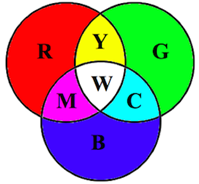 Many students of physics have seen a diagram similar to the one shown at the right. The diagram depicts three circles colored with the primary colors of light - red, green and blue. The primary colored circles overlap to produce other colors of light, known as the secondary colors of light: cyan (C), magenta (M) and yellow (Y). For instance, the red and green light combine to form yellow light. Green and blue light combine to form cyan light. Blue and red light combine to form magenta light.
|